Canadian Aquaculture R&D Review 2015
Table of Contents
Finfish: Freshwater
EFFECT OF STRESS IN SEXUALLY MATURING FEMALE BROOK TROUT (SALVELINUS FONTINALIS) ON EMBRYONIC DEVELOPMENT AND GENE EXPRESSION RELATED TO GROWTH IN THE EARLY DEVELOPMENT STAGES
This project will improve the understanding of the possible molecular impacts that parental stress may have on the fitness of Brook Trout embryos, a cultured species of importance for stocking in Quebec. This research is related to the improvement of production and culture methods, especially with regard to the health of the animals used in aquaculture.
In teleosts, maternal factors such as hormones can enter the oocytes during gonad maturation. In some species, major cortisol concentrations can be transferred into the oocytes when females are subjected to chronic stress during gonadal development. This can have harmful effects on juvenile development. The objectives of this project are to quantify the impact of prenatal maternal stress on: (1) yolk sac volume, development speed, mortality, frequency of malformations, and growth during the early development stages for Brook Trout; and (2) the relative gene expression of growth hormones and their receptors (GH, GHR, IGF 1 and IGF 1r, IGF-2) in fry.
Females were subjected to various chronic stresses during oogenesis (weekly manual stress, feed containing cortisol) and unstressed female eggs were immersed in a cortisol solution for three hours before fertilization. Various phenotypic traits were measured in the offspring of these females throughout embryonic development. Real- time quantitative PCR will be conducted on sampled fry to measure targeted gene expression.
Sep. 2013–Aug. 2015
Funded By: Fonds de recherche du Québec – Nature et Technologies (FRQNT) – Team grants program Co-Funded By: Ressources Aquatiques Québec (RAQ)
Project Lead: Céline Audet (U Québec à Rimouski – ISMER)
Project Team: Laurence Deneault-Tremblay (U Québec à Rimouski – ISMER); Nadia Aubin-Horth (U Laval)
Contact: Celine_Audet@uqar.ca
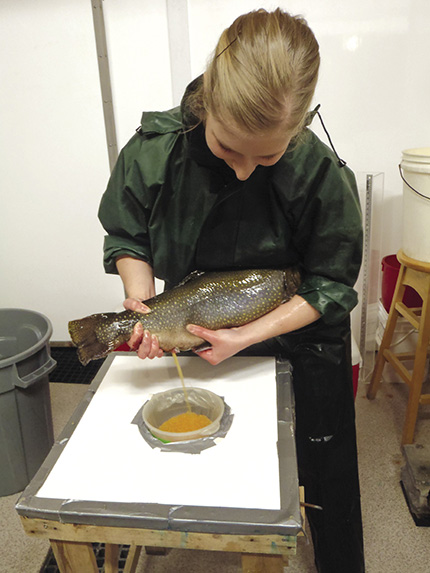
Laurence Deneault-Tremblay extracting Brook Trout eggs. Photo: Laurence Deneault-Tremblay
OPTIMIZATION OF CULTURED WALLEYE (SANDER VITREUS) EGG QUALITY
The goal of this project is to define the nutritional requirements of walleye and to optimize the culture of this species of commercial interest (food, sport fishing) in Canada.
In order to ensure the production of commercial fry and continue the domestication process for Walleye (Sander vitreus), we are optimizing the initial embryonic and larval development phases in eggs produced in captivity to alleviate the need to use wild broodstock. Two major factors were targeted: (1) the use of captive broodstock to determine the “window of opportunity” for extracting eggs while avoiding the over-maturation process and excessive handling of females; and (2) manufacturing feed that meets the Walleye’s nutritional requirements as well as testing its effectiveness on egg quality.
In this project, we verified the impact of broodstock age on egg quality and deduced that younger broodstock produced superior eggs. We also determined the ideal broodstock spawning time that yields the best egg quality and embryonic survival. Lastly, we defined the approximate nutritional requirements for the broodstock in terms of fatty acids, amino acids, and vitamin A.
Sep. 2011–Apr. 2013
Funded By: Société de Recherche et de Développement en Aquaculture Continentale Inc. (SORDAC), Ressources Aquatiques Québec (RAQ) Co-Funded By: Fonds de Recherche Nature et Technologies (BMP Innovation scholarship)
Project Lead: Réjean Tremblay (U Québec à Rimouski)
Project Team: Céline Audet (U Québec à Rimouski); Grant Vandenberg (U Laval); Marco Blanchet (Station piscicole Trois-Lacs)
Collaborators: Ines Ben Khemis, INSTM (Institut national des sciences et technologies de la mer) [National Institute of Marine Sciences and Technologies], Salammbô, Tunisia; Mari Moren (Nofima), Bergen, Norway
Contact: Rejean_Tremblay@uqar.ca
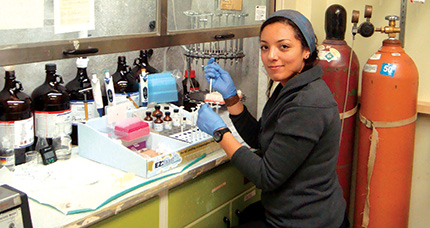
Extraction of amino acids from Walleye eggs. Photo: Jeanette Wells
REARING DEEPWATER CISCO (COREGONUS HOYI) IN CAPTIVITY FROM HATCH FOR RE-Introduction TO LAKE ONTARIO
It is believed that re-introducing Deepwater Ciscoes (Coregonus hoyi) will fill an important ecological niche that is currently vacant in Lake Ontario and will be a major step towards restoring the historical lake biodiversity. Re-establishment of ciscoes may also help generate healthy and stable fish populations throughout the food chain, capable of enduring sustainable exploitation for economic benefit in the future.
Until the mid-1950s, Lake Ontario was home to a diverse assemblage of ciscoes, acting as an important food source for top predators. However, biodiversity of the lake has been greatly reduced due to overfishing, shoreline development causing habitat change, and invasive species. C. hoyi, (“bloater”) was the dominant species of cisco. The current state of the ecosystem is ideal for their successful re-introduction as factors detrimental to ecosystem health have recently been managed by government agencies, favouring increased survival of young ciscoes.
The development of culture techniques and documentation of biological information are key factors in the success of the current project at White Lake Fish Culture Station in Sharbot Lake, Ontario, operated by the Ontario Ministry of Natural Resources (OMNR). The main issue is finding a feed that is both highly acceptable to C. hoyi and nutritionally adequate. These are thought to be the two most critical factors affecting survival of fry. As such, the current project explores the possible benefits of co-feeding a dry diet with Artemia nauplii to encourage a feeding response.
To accomplish the long-term goal of a self-sustaining population in 25 years, the program requires egg collection from Lake Michigan, culture, and stocking of 500,000 juveniles every year starting in 2015.
Feb. 2012–Nov. 2015
Funded By: Ontario Ministry of Natural Resources (OMNR) Co-Funded By: USFWS – Fish and Wildlife Restoration Act; Great Lakes Restoration Initiative
Project Lead: Tim Drew (OMNR)
Project Team: Laura Metcalf, Dominique Bureau (U Guelph); Jim Brumpton (OMNR)
Collaborators: DFO; Chippewa Ottawa Resource Authority; Paragon Fish Corporation; U Guelph
Contact: lmetcalf@uoguelph.ca; Tim.Drew@ontario.ca
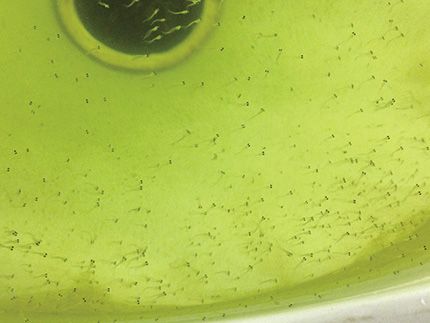
Cisco (bloater) fry, approximately three weeks after hatch. Photo: White Lake Fish Culture Station (OMNR)
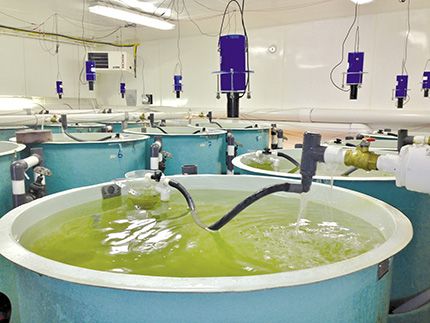
Conical rearing units with individual hatching jars and vibratory feeders hanging above. Photo: White Lake Fish Culture Station (OMNR)
PHYSIOLOGICAL RESPONSES OF TWO CANADIAN STRAINS OF ARCTIC CHARR AT DIFFERENT LIFE STAGES TO DIETS FORMULATED WITH PLANT PROTEIN INGREDIENTS
Through replacing marine-sourced with terrestrial-sourced plant protein ingredients, this research in diet formulation will provide the first insights into the comparative effects of dietary plant protein inclusion in Canadian Arctic Charr. These insights may result in the reduced financial impact of Arctic Charr-targeted feed production, therefore increasing the viability of this species for aquaculture in Canada.
The National Aquaculture Strategic Action Plan Initiative (NASAPI) of the Canadian Council of Fisheries and Aquaculture Ministers (CCFAM) has targeted Arctic Charr as an alternative species holding great potential for Canadian aquaculture. The costs of feed for this species can be as high as 60% of total production depending on growth stage of the fish. As such, methods to reduce the feed budget of this species while maintaining strong growth is of primary concern. The addition of plant protein ingredients to formulated feeds has the potential to replace high cost and low availability marine-sourced ingredients such as fishmeal, while providing the fish with the amino acids required for maximum growth. However, certain plant ingredients contain anti-nutritional factors that have the potential to interact with the fish’s digestive tract and alter the uptake of key nutrients. In related salmonid species, anti-nutritional factors present in soybean meal have been seen to cause intestinal inflammation, reducing protein and lipid uptake, and hindering growth. Therefore, the objectives of this project are to compare the growth, nutrient uptake, and intestinal response in two Canadian strains of Arctic Charr at the starter and grower life stages, fed diets formulated with increasing levels of both soybean and sunflower meal ingredients.
May 2013–Jun. 2014
Funded By: Atlantic Canada Opportunities Agency – Atlantic Innovation Fund (ACOA – AIF) Co-Funded By: Manitoba Association of Agricultural Societies Inc.; Agri-Food Research & Development Initiative (ARDI)
Project Lead: André Dumas (Coastal Zones Research Institute)
Project Team: Amanda Smith, Dominique Bureau (U Guelph); Luc Desjardins (NBCC); Pascale Comeau; Caroline Roussel (CZRI)
Collaborators: Ken Overturf (U Idaho)
Contact: Andre.Dumas@irzc.umcs.ca
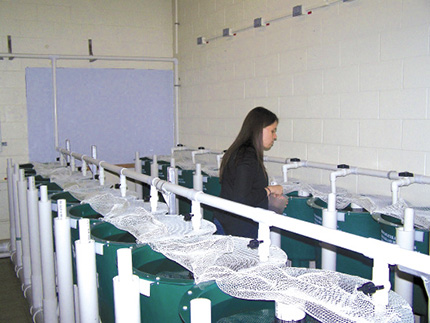
Hand-feeding tanks of juvenile Arctic Charr (Salvelinus alpinus). Photo: Amanda Smith (U Guelph)
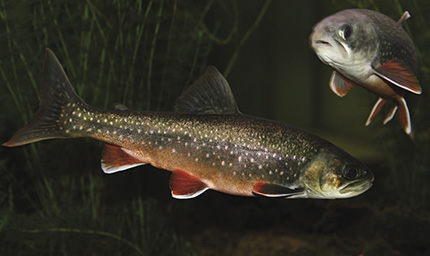
Icelandic Arctic Charr (this species was not used in this particular research project). Photo: Jim Reist (DFO)
GENETIC SELECTION PROGRAM TO ACHIEVE IMPROVED PERFORMANCE OF BROOK TROUT STOCK FOR AQUACULTURE IN QUEBEC
This research has assisted a number of Quebec aquaculture operations in gaining access to certified disease-free eggs exhibiting superior fish performance, thereby improving the profitability of their businesses.
The Brook Trout (Salvelinus fontinalis) is the most widely farmed species in freshwater aquaculture in Quebec. A group of farmers in Quebec, working with Centre de Transfert et de Sélection des Salmonidés (CTSS) Inc., recently launched a genetic selection program with two objectives: (1) to improve growth; and (2) to eliminate precocious sexual maturity. Two different fish strains are being used for this purpose, one of them, a decades-old domestic strain and the other the Rupert strain. The domestication process is ongoing for the Rupert strain, but early results have been encouraging in that the percentage of precocious sexual maturity at age 1+ has dropped from 36.8% to 29% without affecting growth. For the domestic strain, an 11.5% gain in growth has been recorded since the start of the program, while the percentage of precocious sexual maturity at age 0+ has decreased from 34.3% to 8.9%. Throughout the selection process, the CTSS has also ensured that all production fish are certified disease-free. The genetic enhancement process based on use of markers is ongoing.
Jul. 2011–Jul. 2014
Funded By: Ministère de l’Agriculture, des Pêcheries et de l’Alimentation du Québec (MAPAQ) Co-Funded By: Société de développement de l’industrie maricole Inc. (SODIM); Société de recherche et de développement en aquaculture continentale Inc. (SORDAC); Ministère du Développement économique, de l’Innovation et de l’Exportation (MDEIE); Ministère des Affaires municipales, des Régions et de l’Occupation du territoire (MAMROT); Ressources Aquatiques Québec (RAQ)
Project Lead: Luc Picard (CTSS)
Project Team: François Lavigne (CTSS); Louis Bernatchez (U Laval); Dany Proteau (P Lac St-François); Michel Fournier (P des Appalaches); Karl Nolin (P Mont-Tremblant)
Contact: picardl@globetrotter.net
DEVELOPMENT OF GENOMIC RESOURCES FOR ATLANTIC STURGEON USING NEXT-GENERATION SEQUENCING
This project will significantly increase the genomic resources available for Atlantic Sturgeon. Sturgeons are a high value, caviar producing species and its aquaculture has grown exponentially in the last ten years. Market demand and growth can have negative impacts on production such as requirements for higher throughput and densities in culture. These pressures can cause stress and lead to greater susceptibility to pathogens. Clearly, a more comprehensive knowledge of sturgeon biology and genetics is needed to maximize culture and to fulfill the market demand for sturgeon products, including caviar. Unfortunately, genomic information on sturgeon is scarce. Producing these resources may help to identify elite broodstock, optimize culture conditions, and identify biomarkers for health monitoring.
In collaboration with UPEI, the Center for Aquaculture Technologies Canada (CATC) used an RNA-seq approach to identify Atlantic Sturgeon genes responsive to lipopolysaccharide (LPS) stimulation. Due to the duplicated nature of the sturgeon genome, an assembly pipeline was developed using multiple transcriptome assemblers. The transcriptome assembly generated had ~70% read re-mapping. Analysis of differentially expressed transcripts identified sturgeon LPS-responsive genes such as interleukin-8, IRF7 and inhibitory Kappa B Alpha. Additional studies will further improve the Atlantic Sturgeon reference transcriptome and identify single nucleotide polymorphisms.
Aug. 2014–Jan. 2015
Funded By: Natural Sciences and Engineering Research Council (NSERC)
Project Lead: Mark Fast (UPEI)
Project Team: Tiago Hori, Debbie Plouffe (CATC); John Buchanan (CAT)
Contact: thori@aquatechcenter.com
ASSESSING THE BIOAVAILABILITY OF SYNTHETIC METHIONINE AND LYSINE FROM DIFFERENT SOURCES IN RAINBOW TROUT (ONCORHYNCHUS MYKISS)
Both L-lysine HCL and L-lysine sulphate are able to meet lysine requirements of Rainbow Trout with equal efficiency when supplemented on an equimolar basis. Additionally, the lower bioavailability of MHA-Ca, which was found in this study, suggests feed formulators/manufacturers may wish to implement a wider safety margin when including MHA-Ca in diets in order to meet the methionine requirement of an animal.
Supplementing synthetic methionine (Met) and/or lysine (Lys) to diets of terrestrial farm animals to meet their nutritional requirements for Met or Lys is a common practice. Different forms of supplemental Met and Lys are produced and commercialized by various manufacturers. Limited information exists on the bioavailability of these different forms of Met and Lys to fish species.
Using a 12-week growth trial, relative bioavailability of L-methionine and a hydroxy methionine analogue (MHA-Ca) were compared to the commercially prevalent DL-methionine in Rainbow Trout. A separate 12-week trial investigated relative bioavailability between L-lysine HCL and L-lysine sulphate. Basal diets were formulated to be deficient in Met or Lys and were supplemented with increasing equimolar levels of Met or Lys from three sources of Met or two sources of Lys. Using a linear slope-ratio assay, bioavailability of L-methionine and DL-methionine were determined to be similar (p>0.10). Differences in bioavailability between DL-methionine and MHA-Ca were observed (p<0.05), with MHA-Ca being 69, 60, and 73% as bioavailable as DL-methionine based upon weight gain, growth rate (thermal-unit growth coefficient), and retained nitrogen response parameters, respectively. L-lysine HCL and L-lysine sulphate were effective sources of lysine with no significant differences in bioavailability (p>0.10).
May 2012–Aug. 2014
Funded By: Evonik Industries AG, Hanau, Germany Co-Funded By: Ontario Ministry of Agriculture Food and Rural Affairs (OMAFRA)
Project Lead: Christopher Powell, Dominique Bureau (U Guelph)
Project Team: Kabir Chowdhury
Collaborators: Andreas Lemme
Contact: cpowell@uoguelph.ca, dbureau@uoguelph.ca
DEVELOPMENT OF TECHNIQUES TO PROMOTE THE SURVIVAL AND GROWTH OF WALLEYE (SANDER VITREUS) LARVAE IN INTENSIVE CULTURE
The objective of this project is to promote Walleye production in Canada by reducing the financial risks associated with high mortality in the larval stage and establishing farming parameters to support optimal growth.
The Walleye (Sander vitreus) is a species with high commercial and recreational value in the Northern United States and Canada. Culture of this species has strong economic potential but has not been widely adopted as intensive production has yet to prove successful. Problems involving cannibalism, Non-inflation of the swim bladder, and feed ingestion have been leading to fish kills within the first few days after egg hatching. This project consequently aims to lay the groundwork for making Walleye production cost-effective by testing culture techniques currently in use elsewhere around the world and to develop new processes for promoting survival and growth at the larval stage. Various dietary treatments incorporating the use of live food and plant and/or animal protein-based feed will be tested. Additional parameters will also be evaluated, such as turbidity agents, the photoperiod, light levels, and the use of water jets and surface air. The project will ultimately lead to an economically viable plan for intensive Walleye production in keeping with demand among the table and stocking markets.
May 2014–Dec. 2015
Funded By: Ministère de l’agriculture, des pêcheries et de l’alimentation du Québec (MAPAQ) – INNOVAMER
Project Lead: Grant Vandenberg (U Laval)
Project Team: Émilie Proulx, Benjamin Laramée (U Laval)
Collaborators: Réjean Tremblay, Céline Audet (ISMER, UQAR); Marie-Hélène Fournier (Merinov); Marco Blanchet (Station piscicole Trois-Lacs)
Contact: Grant.Vandenberg@fsaa.ulaval.ca

Walleye (Sander vitreus) larva, 23.2 mm in length on day 24 post-hatching. Photo: Benjamin Laramée (U Laval)
STUDY OF THE DIGESTIBILITY OF FLY LARVAE PRODUCT-BASED DIETS IN RAINBOW TROUT
The objective of this project is to provide a rational basis for the formulation of new types of salmonid feed and, in so doing, demonstrate their potential for the Canadian aquaculture industry.
Incorporating fly meal into aquaculture feed formulations would help to reduce costs associated with the supply of fishery products as well as the industry’s ecological footprint through the recovery of other industries’ waste organic matter. However, achieving these goals depends on the capacity of meal producers to supply a consistently high-quality product that meets the needs of fish species. The choices of species, larvae production processes (substrate, environment, etc.) and product processing methods are factors potentially affecting product composition and nutritional quality. Our project aims to conduct assessments of the composition of larvae products (brown and white meals) from the Housefly (Musca domestica) and Black Soldier Fly (Hermetia illucens) grown on various substrates and then proceed with preliminary dietary testing in the Rainbow Trout to gauge nutritional quality. The composition and digestibility of foods containing 30% fly meal will be determined through analysis of total content (energy, dry matter, ash, fat, and protein) and establishment of mineral, amino acid, and fatty acid profiles.
Sep. 2014–Aug. 2015
Project Lead: Grant Vandenberg (U Laval)
Project Team: Marie-Hélène Deschamps, Émilie Proulx (U Laval)
Collaborators: Charles Lavigne, Catherine Emond (Quebec Agrifood Development Center [CDBQ]); Cliff Pavlovic (Corporation Larvatria)
Contact: Grant.Vandenberg@fsaa.ulaval.ca

Housefly (Musca domestica) and Black Soldier Fly (Hermetia illucens) larvae. Photo: Marie-Hélène Deschamps, Emilie Proulx (U Laval)
THE TRANSCRIPTOME AS A TOOL FOR UNDERSTANDING AND EARLY DETECTION OF VERTEBRAL MALFORMATIONS LINKED TO PHOSPHORUS DEFICIENCY IN RAINBOW TROUT
Our goal is to understand the mechanisms triggering the occurrence of skeletal anomalies in farmed Rainbow Trout relating to dietary phosphorus intake. Our ultimate objective is to improve the formulation of low-phosphorus feed and support the selection of superior-performing, less polluting strains.
The occurrence of bone malformations in farmed fish poses a major financial challenge for farms in addition to raising ethical questions relating to animal well-being. Our studies have shown that a phosphorus (P) deficiency had significant impact on the occurrence of these malformations. However, previous studies have highlighted the difficulty of establishing an animal’s specific needs with a view to identifying optimal P concentrations in feed. Using a leading-edge transcriptomic approach (RNA sequencing), it is now possible to detect changes in overall gene expression at specific moments relating to abnormal animal development. As such, our studies have shown that in fish with a P deficiency that develop malformations, a number of signalling pathways identified in humans are also affected in the Rainbow Trout. These events appear to lead to abnormal bone mineralization and decreased robustness, potentially making the bone more susceptible to malformations. Our studies have also shown that some malformations could be reversible up to a certain point. These advanced detection tools could also be used to prevent and/or limit the occurrence of adverse structural changes in animals during the rapid growth phase.
Sep. 2010–Aug. 2014
Funded By: Ministère du Développement économique, de l’Innovation et de l’Exportation – Programme de soutien à des initiatives internationales de recherche et d’innovation (PSIIRI) Co-Funded By: DFO – Aquaculture Collaborative Research and Development Program (DFO – ACRDP); Programme de recherche et de développement en aquaculture continentale (SORDAC); Réseau Aquaculture Québec – Programme de bourse FONCER; Université Laval – Programme de bourse du Bureau International
Project Lead: Grant Vandenberg (U Laval)
Project Team: Marie-Hélène Deschamps, Jérémy Le Luyer, Noémie Poirier Stewart, Émilie Proulx (U Laval)
Collaborators: Nadia Aubin-Horth, Claude Robert, Arnaud Droit (U Laval); Dominique Bureau (U Guelph); Ann Huysseune, Eckhard Witten (Universiteit Gent); Jean-Yves Sire (U Paris 6); Chantal Cahu, Dominique Mazurais (IFREMER); Kenneth Overturf, Ron Hardy (U Idaho); Tom Hansen, Anna Wargelius, P.E. Fjelldal (Havforskningsinstituttet)
Contact: Grant.Vandenberg@fsaa.ulaval.ca
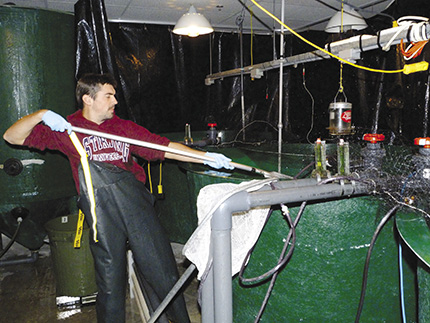
Cleaning the tanks. Photo: Emilie Proulx (U Laval)
DEVELOPMENT OF PREDICTIVE MODELING TOOLS TO ASSIST WITH FRESHWATER AQUACULTURE SITE LICENSING DECISIONS
Governmental agencies charged with the responsibility of licensing and regulation of the aquaculture industry are in need of objective tools to assist in their decision-making processes. The development of such tools would similarly be of benefit to the industry, as currently the primary factor limiting the expansion of the freshwater industry is access to new sites. The lack of tools to estimate ecological consequences of new sites has resulted in a very precautionary atmosphere, a complex and expensive application process and, ultimately, limited development of the industry.
The primary environmental concerns with cage aquaculture are related to benthic impacts and exceedance of the assimilative capacity of an ecosystem for nutrient inputs. Cage aquaculture has the potential to have far-ranging impacts on the lake ecosystem. Increased nutrient inputs can affect overall ecosystem productivity and excessive nutrient inputs can lead to eutrophication, which may include such undesirable consequences as development of nuisance algal blooms, oxygen deficient, and loss of biodiversity. The deposition of solid wastes under farms contributes to increased sediment oxygen demand as well as the potential to significantly alter the quality of benthic habitat and the composition of benthic communities beneath and surrounding farms.
Apr. 2008–Mar. 2015
Funded By: DFO – Aquaculture Collaborative Research and Development Program (DFO – ACRDP) Co-Funded By: Wild West Steelhead
Project Lead: Cheryl Podemski (DFO)
Collaborators: Wild West Steelhead
Contact: Cheryl.Podemski@dfo-mpo.gc.ca
www.dfo-mpo.gc.ca/aquaculture/acrdp-pcrda/index-eng.htm
TOWARD EARLY DETECTION OF VERTEBRAL ANOMALIES LINKED TO PHOSPHORUS DEFICIENCY IN FARMED RAINBOW TROUT THROUGH MORPHOMETRIC MEASUREMENTS TAKEN FROM X-RAYS
Our goal is to understand the mechanisms triggering the occurrence of skeletal anomalies in farmed Rainbow Trout relating to dietary phosphorus intake and to be able to describe in detail the morphological changes occurring in the vertebral structure.
The development of vertebral anomalies is a recurring problem in intensive salmonid culture that generates financial losses and raises ethical concerns. Our research on vertebral malformations induced by prolonged phosphorus deficiency has enabled identification of the anomalies characteristic of phosphorus deficiency as well as the vertebral phenotypic plasticity exhibited by farmed Rainbow Trout. Under the same conditions, the caudal vertebrae of Rainbow Trout exhibited four different development scenarios: (1) development and maintenance of a normal phenotype (17% of individuals); (2) development of an abnormal phenotype followed by full recovery (24%); (3) development and maintenance of an abnormal phenotype (16%); and (4) development of an abnormal phenotype followed by phenotype deterioration (16%). Morphometric measurements taken from x-rays of the vertebrae combined with analysis of histological sections enabled detection of morphological changes otherwise imperceptible upon visual x-ray analysis. We therefore proposed a standardized method for early detection of these types of vertebral anomalies that may be used by stakeholders throughout the Canadian aquaculture industry to ensure optimal vertebral development.
Sep. 2010–Aug. 2014
Funded By: Ministère du Développement économique, de l’Innovation et de l’Exportation – Programme de soutien à des initiatives internationales de recherche et d’innovation (PSIIRI) Co-Funded By: DFO – Aquaculture Collaborative Research and Development Program (DFO – ACRDP); Programme de recherche et de développement en aquaculture continentale (SORDAC); Réseau Aquaculture Québec – Programme de bourse FONCER; Université Laval – Programme de bourse du Bureau International
Project Lead: Grant Vandenberg (U Laval)
Project Team: Marie-Hélène Deschamps, Jérémy Le Luyer, Noémie Poirier Stewart, Émilie Proulx (U Laval)
Collaborators: Nadia Aubin-Horth, Claude Robert, Arnaud Droit (U Laval); Dominique Bureau (U Guelph); Ann Huysseune, Eckhard Witten (Universiteit Gent); Jean-Yves Sire (U Paris 6); Chantal Cahu, Dominique Mazurais (IFREMER); Kenneth Overturf, Ron Hardy (U Idaho); Tom Hansen, Anna Wargelius, P.E. Fjelldal (Havforskningsinstituttet)
Contact: Grant.Vandenberg@fsaa.ulaval.ca
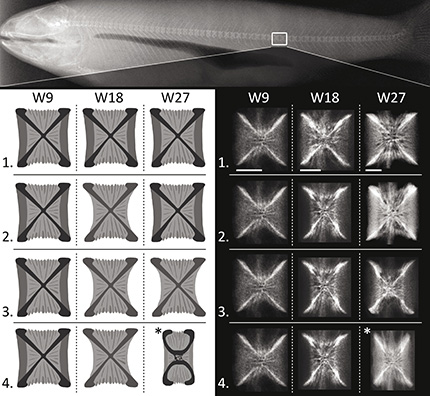
Schematic depiction and x-rays of the four vertebral development scenarios observed in the study. Scenarios are depicted in three stages representing the beginning, middle, and end, respectively, of the experimental phase (weeks 9, 18, 27). The vertebrae shown display two types of malformations: biconcave and compressed. Image: from Poirier Stewart et al., J. Appl. Ichthyol. 30 (2014), p.796–803
TOWARD BETTER CHARACTERIZATION OF WASTE (NITROGEN, PHOSPHORUS, SOLIDS) GENERATED BY TROUT FED WITH COMMERCIAL FEED CURRENTLY USED IN CANADA
Eutrophication of watercourses, into which waste from aquaculture operations flow, constitutes the most concerning environmental impact for the Canadian trout aquaculture industry. Significant efforts have been made in recent years to reduce the quantity of nutrients [i.e., phosphorus (P), nitrogen (N), and suspended solids) emitted by fish culture. New feeds have, therefore, been developed to limit the total quantity of P and N in waste from cultivated fish stocks. Accurate bioenergetic models have also been developed to determine fish growth, feeding standards, and retention and excretion of nitrogen and phosphorus. However, accurate coefficients must be determined to operate these models and these values vary depending on the fish stock and feed used. The goal of this study was to accurately determine the growth and apparent digestibility coefficients of the nutrients in various commercial feeds for Rainbow Trout (50 to 500 g) and Brook Trout (50 to 250 g) of different sizes in temperatures of 8°C and 14°C.
Proximate analysis of the 22 commercial feeds examined showed that most of the feeds had phosphorus content below the posted maximum commercial values. Differences of -30% to 20% were observed between the actual and theoretical contents. Growth and apparent digestibility coefficients were determined for each feed based on the species, life stage, and culture temperature. The results obtained relative to the characterization of waste (i.e., nitrogen, phosphorus, and solids) varied depending on the feeds and production batches. These new coefficients will be used in mathematical models to estimate the quantity of nutrients released by operations. The data obtained will help aquaculture regulators and the industry evaluate the systems required to process effluents and reduce the sector’s ecological footprint.
Apr. 2009–Mar. 2013
Funded By: DFO – Aquaculture Collaborative Research and Development Program (DFO – ACRDP) Co-Funded By: Industrial Action Plan of the Interprovincial Partnership for Sustainable Freshwater Aquaculture Development (IPSFAD)
Project Lead: Grant Vandenberg (U Laval)
Project Team: Éric Boucher, Annie Dubé, Émilie Proulx (U Laval)
Collaborators: Industrial Action Plan of the Interprovincial Partnership for Sustainable Freshwater Aquaculture Development (IPSFAD)
Contact: Grant.Vandenberg@fsaa.ulaval.ca
www.dfo-mpo.gc.ca/aquaculture/acrdp-pcrda/index-eng.htm
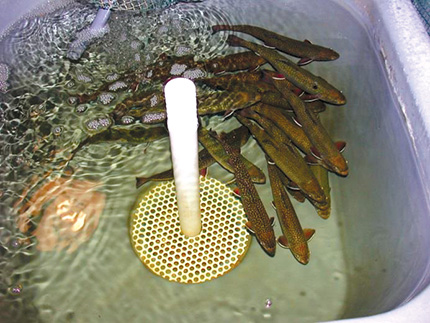
Trout housed in a tank at University of Laval. Photo: Grant Vandenberg (U Laval)
META-ANALYSIS OF FRESHWATER AQUACULTURE PROVINCIAL WATER QUALITY MONITORING DATA
Recent increases in production capacity in Ontario, Saskatchewan, and British Columbia have prompted regulators to consider strategies for managing freshwater finfish aquaculture, in particular, ecosystem carrying capacity which is tightly coupled with the phosphorus released in aquaculture waste. Currently in Ontario, a water quality monitoring program is imposed as a condition to aquaculture licenses to ensure that the release of phosphorus from finfish farms does not exceed regulatory thresholds. The program, however, does not address phosphorus levels near or downstream from freshwater finfish farms, or if phosphorus concentrations have increased over the decade that sampling has been conducted. One of the primary environmental concerns restricting the expansion of the freshwater finfish cage industry is the ability of the environment to assimilate waste, in particular phosphorus. Phosphorus is the nutrient that limits the biomass of primary producers; excessive amounts of phosphorus released from aquaculture cages pose a risk of eutrophication in freshwater ecosystems.
A decade of water monitoring data collected through the historic Ontario monitoring program will be analyzed to determine if there is evidence that freshwater finfish cages are contributing to elevated phosphorus concentrations and to the eutrophication in the environment. Given the link between assimilation of phosphorus and carrying capacity, the results of this project will provide further insight to the role of ecosystem carrying capacity in accommodating sustainable expansion of the industry.
Aug. 2014–Mar. 2015
Funded By: DFO – Program for Aquaculture Regulatory Research (DFO – PARR)
Project Lead: Cheryl Podemski (DFO)
Contact: Cheryl.Podemski@dfo-mpo.gc.ca
EFFECTS OF ENZYMES TREATED RED YEAST ON GROWTH, ASTAXANTHIN DIGESTIBILITY, AND PIGMENTATION OF RAINBOW TROUT
This research may offer an effective way to reduce the cost of pigmentation in the production of salmonids. The muscle colour of Rainbow Trout is an important quality attribute, which has a major impact on consumers’ perception and willingness to pay. The red/pink color of the fillet is achieved by the deposition of carotenoid pigments, mainly astaxanthin, within muscle fibers. Fish are unable to synthesize astaxanthin de novo, hence it must be obtained through dietary sources. Pigment supplementation may represent up to 15% of the total feed costs due to the high price of synthetic astaxanthin. Astaxanthin from single cell organisms are a protein-rich alternative source of pigments for aquaculture feed. Until now, the incomplete breakage of red yeast is the main obstacle that results in low astaxanthin digestibility and poor pigmentation in fish. Previous research showed that there was a positive relationship between the degree of enzymatic cell wall disruption and astaxanthin deposition in muscle when Rainbow Trout were fed diets supplemented with red yeast. Thus, the objectives of this study are: (1) to assess effects of a glucanase-protease combination on the availability of astaxanthin from red yeast in vitro trial; and (2) to assess the effects of enzyme complexes on astaxanthin digestibility, growth, and muscle pigmentation of Rainbow Trout.
May 2014–Jan. 2015
Funded By: Jefo Nutrition Inc.
Project Lead: Dominique Bureau (U Guelph)
Project Team: Xinwen Yi, Patricio Saez (U Guelph)
Contact: dbureau@uoguelph.ca
REDUCING THE PROBLEM OF EARLY SEXUAL MATURATION IN ARCTIC CHARR (SALVELINUS ALPINUS)
Early sexual maturation among diploid Arctic Charr and other farmed salmonids remains a serious problem, reducing meat quality and revenue. Photoperiod, temperature, and food availability exert a strong influence on somatic growth and the decision to commence sexual maturation, but how they interact is unclear. Fraser River Arctic Charr is a good model for study as both sexes suffer a high rate of early sexual maturation age 2+ in culture, a trait that has limited its commercialization in Canada. Initial trials established 24 h light (LL) for several months during winter age 1+ reduced significantly the maturity rate age 2+ in a step-wise manner, the earlier LL started in autumn the fewer mature fish. Paradoxically, gonadal maturation was stimulated by the onset of LL, and was subsequently arrested by the return of the natural day length in April–May. Ongoing trials are quantifying the relative importance of the three phases of the LL photoperiod regime: LL start date, LL duration, and LL end date. The best LL regime might cut the maturity rate to 40%, but this is still too high for farmers. Substantial further reductions in maturity rate to <10% was achieved recently when we combined LL with a period of food deprivation and reducing temperature from 10˚C to 5˚C. Compensatory growth following the return to full ration indicates the technique is useful to growers. Moreover, knowing how to switch off maturation provides a means to explore the neuroendocrine mechanisms controlling seasonal maturation.
Sep. 2013–Ongoing
Funded By: Atlantic Innovation Fund
Project Lead: Jim Duston (Dalhousie U)
Project Team: Qi Liu (Dalhousie U)
Collaborators: Andre Dumas (CZRI); Tony Manning (RPC)
Contact: jduston@dal.ca
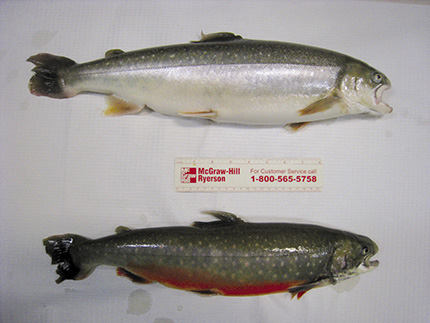
Marketable silvery charr held by Qi Liu, and unmarketable mature charr held by Minmin Wei. Photo: Paul MacIsaac (Dalhousie U)
ASSESSING ECOLOGICAL INTERACTIONS BETWEEN AQUACULTURE AND WILD STRAINS OF RAINBOW TROUT
Whole-ecosystem studies are critical to understanding the potential consequences that growth-enhanced strains of fish used in commercial aquaculture may pose to wild fish communities. We conducted laboratory trials and whole-ecosystem studies to investigate the differences in growth and survival of aquaculture versus wild (or naturalized) strains of Rainbow Trout common to Lake Huron. From growth trials, we documented that the strain of Rainbow Trout used in commercial production in Lake Huron grew to double the size of wild fish. Rapid growth of aquaculture strain fish was achieved by greater feed consumption and higher feeding efficiency relative to wild fish.
Next, we stocked equal densities of these same Rainbow Trout strains into a small, boreal lake. Both trout strains occupied similar near-shore habitat, and experienced equally low survival. This we attributed to predation from loons and mergansers. The aquaculture strain segregated into a fast-growing group (~3x growth relative to the wild strain), and a slow-growing group that had a lower growth rate than wild trout. Fast-growing aquaculture trout had the greatest proportion of high energy prey (minnows) in their diet, whereas wild fish were more reliant upon insects.
Our findings demonstrate that the aquaculture strain of Rainbow Trout, which is present in Lake Huron through escape from net pens, has the potential to outcompete wild strains when they occupy similar near-shore habitats.
May 2010–Mar. 2013
Funded By: DFO - Centre for Aquatic Biotechnology Regulatory Research (DFO – CABRR)
Project Lead: Paul Blanchfield (DFO)
Project Team: Robert Devlin, Alex Wall (DFO); Matthew Martens (U Manitoba)
Contact: Paul.Blanchfield@dfo-mpo.gc.ca
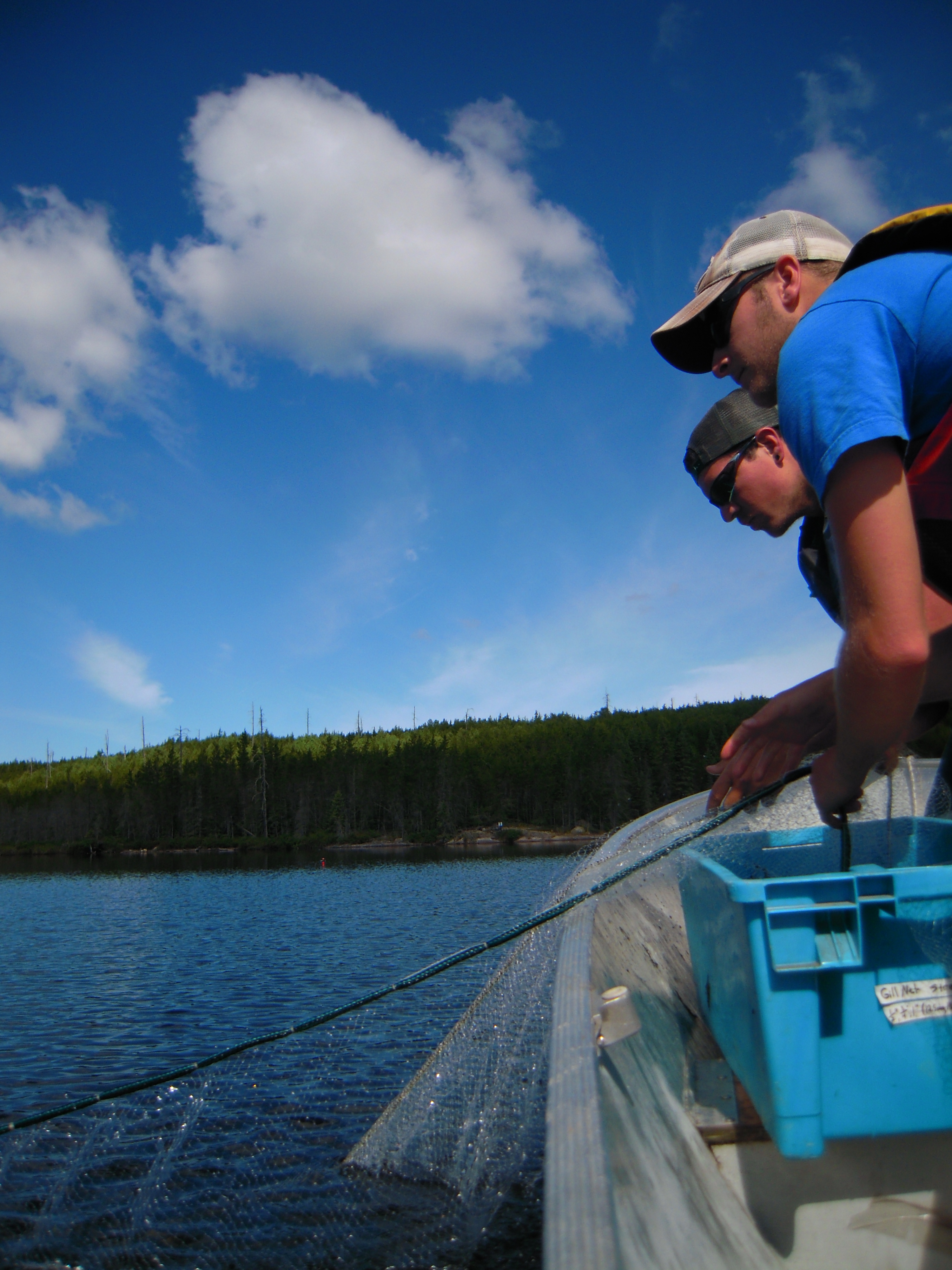
University of Manitoba graduate students Matt Martens (left) and Matt Guzzo (right) gillnet for aquaculture and wild strains of Rainbow Trout stocked at the Experimental Lakes Area, Ontario. Photo: Alex Wall (DFO)
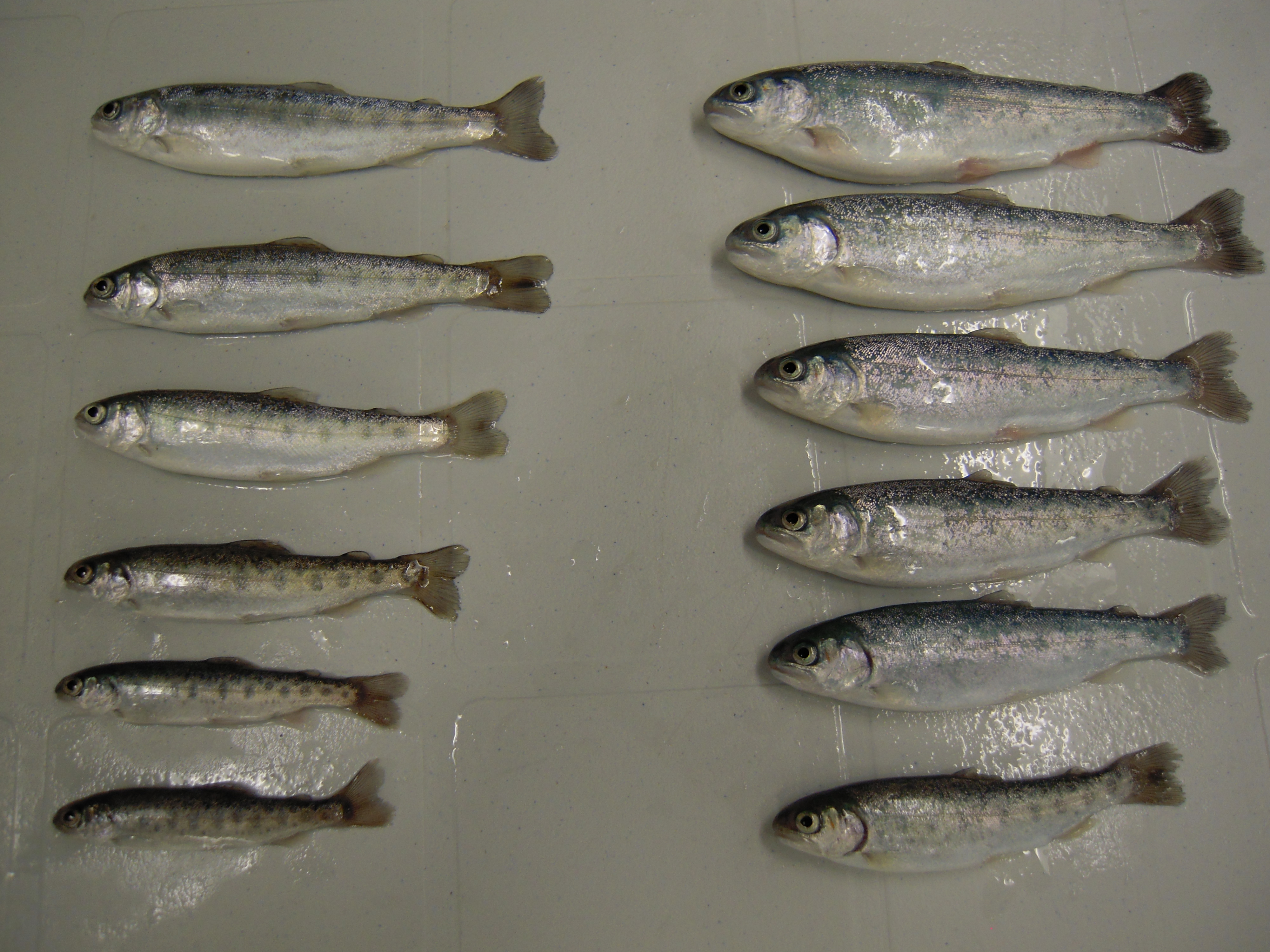
A strain of Rainbow Trout used in commercial aquaculture in Lake Huron (right) has enhanced growth compared to the wild strain (left) from Lake Huron. Photo: Alex Wall (DFO)
EVALUATION OF GROWTH PERFORMANCE AND PRODUCT QUALITY OF ARCTIC CHARR (FRASER STRAIN - SIXTH GENERATION) REARED IN A COMMERCIAL OPERATION
Arctic Charr is listed as an alternative species that holds great potential for commercial aquaculture in Canada. The objective of the project is to evaluate the performances as well as product quality of Arctic Charr (Fraser strain, 6th generation) in a local commercial fish farm. These fish will be reared under intensive conditions until they reach market size (about 1300 g). In July 2014, the mean body weight of juveniles was 7 g. From July to October 2014, the feed conversion and thermal-unit growth coefficient were 0.88 and 0.229, respectively. The average temperature was 8.6°C. The mean stocking density was 36 kg/m3. Only 0.9% mortality was observed so far. This major project is the first of its kind to be conducted on the Fraser strain at a commercial scale.
The results will serve as an indication of the performance that can be expected from this strain in a typical commercial rearing environment. These results will also be used to plan the financial aspects of commercial businesses.
Jul. 2014–Dec. 2015
Funded By: Department of Agriculture, Aquaculture and Fisheries of New Brunswick Co-Funded By: NRC – Industrial Research Assistance Program (NRC – IRAP); Pisciculture Acadienne (PA); Coastal Zones Research Institute (CZRI)
Project Lead: Claude Pelletier (CZRI)
Project Team: Luc Desjardins (NBCC); Michel Desjardins (NBDAAF); Emmanuel Chiasson, André Vienneau, Robert Mallet (PA); André Dumas (CZRI)
Collaborators: Pisciculture Acadienne (PA)
Contact: Claude.S.Pelletier@irzc.umcs.ca

Fraser strain Arctic Charr.
EVALUATION OF RATION REDUCTIONS ON THE GROWTH, FEED CONVERSION, AND SOMATIC INDICES OF RAINBOW TROUT
In this study, Rainbow Trout were fed by hand to near satiation for two days followed by a reduction in the amount of feed fed for the remaining five days of the week. The reduction in food presented was based on a percentage of the total feed taken during the previous two hand feeding events. The ration reduction levels were to 88%, 81%, 74%, and 67% of satiation. A fifth ration strategy involved feeding by hand to near satiation for two days followed by one day of fasting. The feed was then reduced to 85% of satiation for the remaining four days of the week.
There were no significant differences in growth, degree of population size variation, mortalities, or visceral weight to total body weight (viscerosomatic index or dress-out loss) due to degree of ration reduction in this trial. The only differences of significance occurred with the feed conversion ratios (FCR). As the degree of ration reduction increased, the FCR’s improved without impacting growth. The poorest feed conversion ratio was at the 88% ration level (FCR = 1.23). Fish fed at the 67% ration level and at the 85% + one day fasting ration level had significantly better FCR’s than those fed at the 88% ration levels.
The efficiency with which fish utilize a food supply is a major factor determining the economic returns of a fish farm. While research has investigated the dietary requirements of Rainbow Trout resulting in the formulation of highly effective diets, the quantity of food eaten and the manner in which it is presented to Rainbow Trout and its effects on growth rate and feed conversion efficiencies have been less studied.
Jan. 2013–Oct. 2013
Funded By: Martin Mills Inc. Co-Funded By: Ontario Ministry of Agriculture, Food and Rural Affairs
Project Lead: Richard Moccia (U Guelph)
Project Team: Mark Wagner (Martin Mills Inc.)
Collaborators: Alma Aquaculture Research Station (U Guelph)
Contact: rmoccia@uoguelph.ca
www.aps.uoguelph.ca/aquacentre/
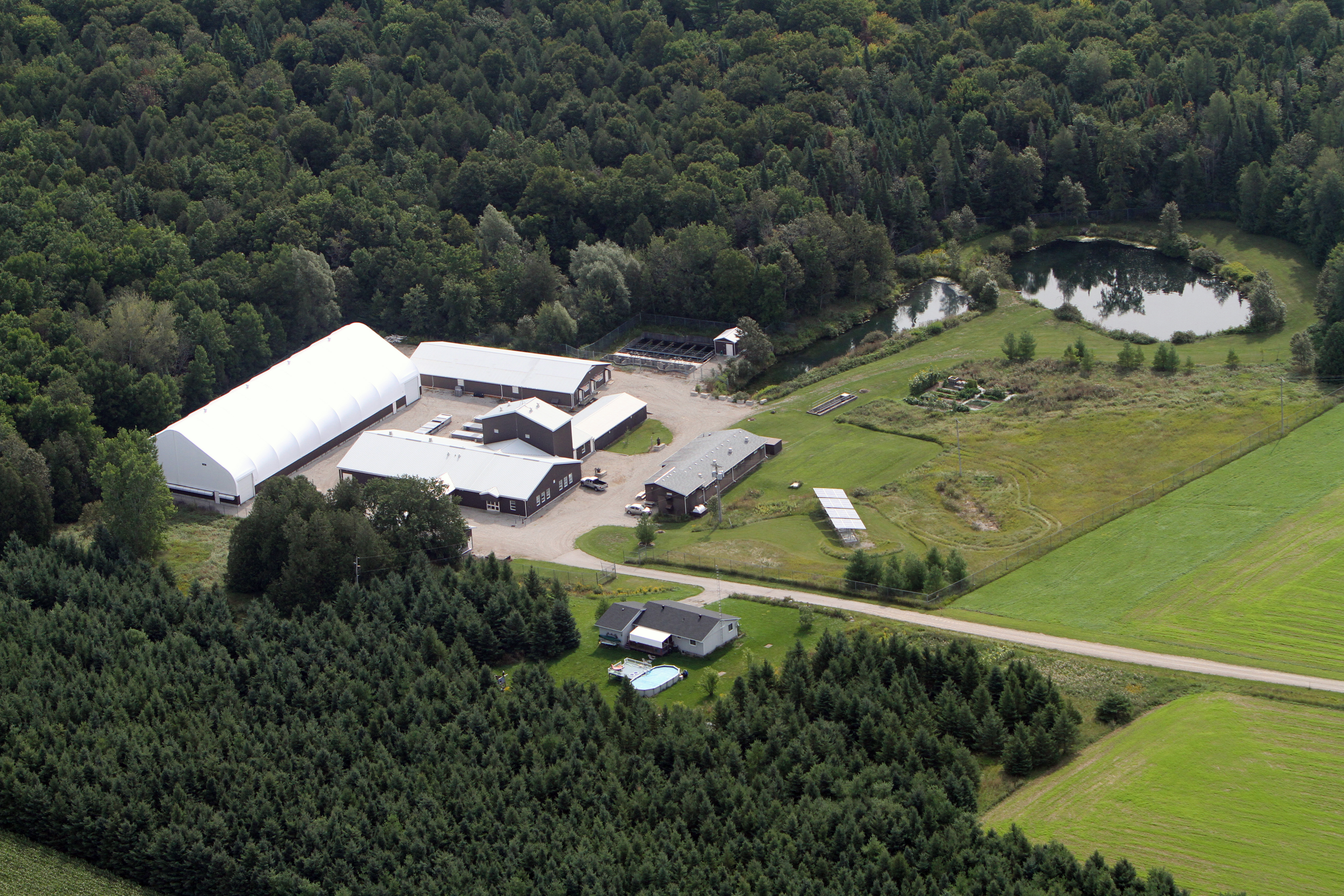
Alma Aquaculture Research Station. Photo: University of Guelph
AQUASTATS: ONTARIO AQUACULTURE STATISTICS PROGRAM
In 2013, we estimate that Ontario fish farms produced 3,580 tonnes of Rainbow Trout, primarily for human consumption. Lake-based cage production of Rainbow Trout in the Georgian Bay area accounts for 89% of the total production. Our records suggest that approximately 55-60 facilities culture Arctic Charr, tilapia, Brook Trout, bass and other species, with an estimated total production of 210 tonnes in 2013.
The total farm-gate value of the 3,580 tonnes of Rainbow Trout produced is estimated to be $18 million, with an average price of $5.02/kg. The sale of Arctic Charr, tilapia, Brook Trout, bass and other fish species is estimated to be an additional $1.2 million. More than 40 facilities are involved with pond stocking, typically Rainbow Trout, Brook Trout and bass, conservatively estimated to be $1.5 million annually.
The Ontario aquaculture industry is estimated to have generated a total of 172 person-years of direct, on-farm employment (107 person-years of full-time and 65 person years of part-time employment). Indirect employment is conservatively estimated at 150 person-years. The total annual contribution that aquaculture makes to the Ontario economy is estimated to be $60 million, with additional economic value realised via the recreational and aquaria trade.
Jan. 2013–Mar. 2013
Funded By: Ontario Ministry of Natural Resources Co-Funded By: Ontario Ministry of Agriculture, Food and Rural Affairs
Project Lead: Richard Moccia (U Guelph)
Project Team: David Bevan (U Guelph)
Collaborators: Sarah Desjardins
Contact: rmoccia@uoguelph.ca
- Date modified:
